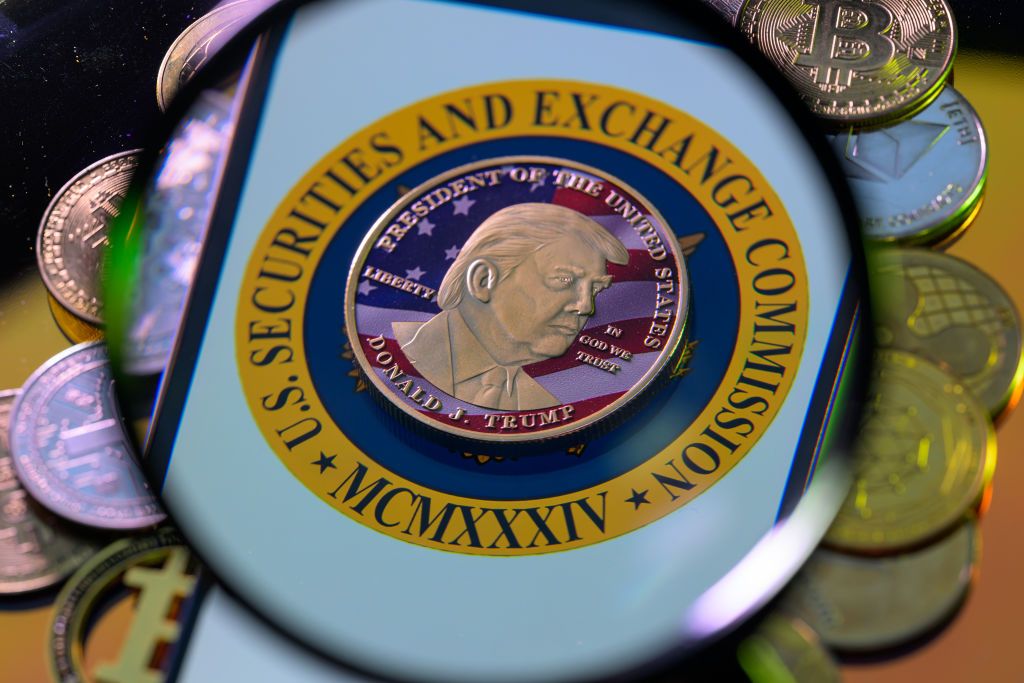On Wednesday, the team behind the official Donald Trump memecoin sparked a trading frenzy after announcing that the investors who held the largest amount of the crypto coin in the coming weeks would be invited to a gala dinner attended by the US president.
“At this intimate private dinner, hear first-hand president Trump talk about the future of crypto [sic],” reads the listing on the TRUMP coin website. “The most exclusive invitation in the world. Only for the top 220 $TRUMP meme coin holders.” The dinner is set to take place on May 22.
Traders rushed to buy up the TRUMP coin, some trying to bump themselves onto the invite list and others simply hoping to profit, according to analysis by blockchain analytics firm Nansen. Within an hour, its price had surged by almost 60 percent.
However, for the two organizations that own 80 percent of the coin’s supply—CIC Digital LLC and Fight Fight Fight LLC, offshoots of a conglomerate owned by Trump—the market price was a secondary concern. In the immediate term, those firms profit primarily based on how frequently people trade it.
When Trump announced his memecoin in January, the two organizations funneled 10 percent of the total supply into a so-called liquidity pool, the purpose of which is to ensure the asset can be traded freely. In return for supplying liquidity and promising to buy and sell the coin as trades come in—known as market making—the Trump-affilitated organizations command a fee. That fee ranges from 0.1 to 10 percent of each trade depending on the present level of demand. Think of it like surge pricing on a ride-hailing app.
“If you have a coin and you control the market making and the fees generated, what you care about is volume and price movement, not price itself,” says Nathan van der Heyden, head of business development at crypto company Aragon.
Previously, Trump-affilitated entities have reportedly earned tens of millions of dollars in trading fees in connection with the TRUMP coin. In the 24 hours following the dinner announcement, $1.6 million in fees were collected by contributors to the TRUMP liquidity pool on Meteora, the exchange through which the token was originally launched. Most of that money will have accrued to CIC Digital and Fight Fight Fight as the largest contributors to the pool, based on previous reports.
On paper, the Trump-affilitated organizations also stand to gain by any appreciation in the price of TRUMP, as they are by far the largest holders. But in practice, they are prevented from selling their stash of coins, partly by a mechanism that limits access to their holdings for a three-year period, and partly by the prospect of a backlash resulting from the inevitable drop in price caused by any large sales.
“The optics of profiting from selling your own coin are terrible, while profiting from the market making is opaque enough to protect your reputation,” says van der Heyden.
Meanwhile, anyone who bought into TRUMP as the price surged on Wednesday risks ending up out of pocket. Jockeying for a seat at the gala dinner is a powerful incentive to buy. Once that goes away the price of the Trump coin is likely to fall, analysts say, even if the possibility of future dinners and other perks for owners of the coin might temper any dropoff.
“Very likely there would be a slump afterwards,” says crypto analyst Noelle Acheson, formerly of crypto brokerage Genesis.
Even as the price of TRUMP rose after the announcement, sophisticated crypto investors with a track record of profitability—so-called smart money traders—sold their stakes in the coin, according to Nansen. “Smart money isn’t interested in the TRUMP token, I can tell you that,” says Nicolai Søndergaard, research analyst at Nansen.
When Trump first announced his memecoin, days before the inauguration, critics accused the incoming president of embarking on a money-grab at the expense of his regular supporters. Others worried that the coin could act as a vector for bribery; by investing large sums into the coin, driving up its price, politically motivated actors could in theory curry favor with the president surreptitiously.
The dinner gambit—an apparent attempt to sell access to the sitting president and manufacture a surge in trading—represents the potential culmination of those fears. The largest holders that have put themselves forward for the dinner are listed in a leaderboard on the TRUMP coin website, but their identities are concealed behind alphanumeric crypto wallet addresses.
The White House did not respond immediately to a request for comment.
“Crypto industry insiders have pretty much fully understood that Trump’s understanding of crypto is extremely superficial,” claims van der Heyden. “He only cares because he sees potential personal gains.”




